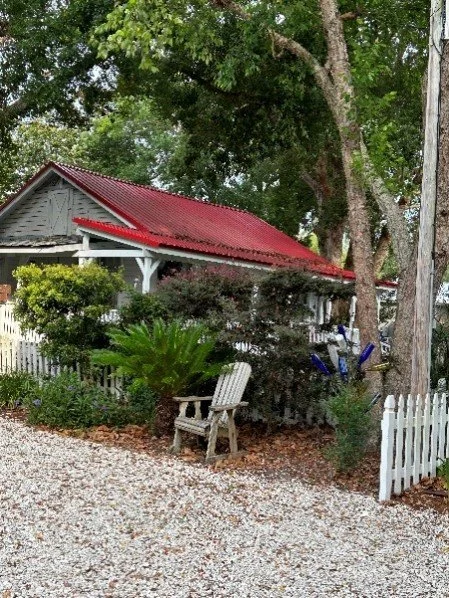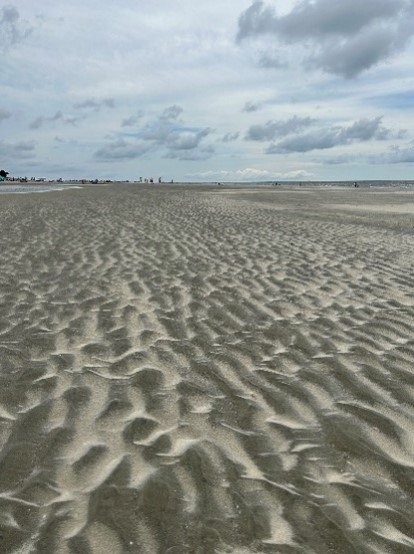St. Simons Island Getaway, Summer 2023
My daughter and I recently spent a few days on St. Simons Island for a little rest and relaxation, some beach time. When she had arranged this Mother’s Day present, she had originally booked a room on Jekyll Island, but when a friend offered his beach cottage, we quickly changed our plans. It is an adorable cottage dating back to the 1930s and just a few minutes’ walk to the beach and near the historic downtown and its restaurants.
We had been to Jekyll Island a few times for family reunions, once to celebrate my parents’ 60th wedding anniversary and the last time to celebrate Dad’s 90th birthday and share Christmas together. That last visit Wally and I had driven from Texas to Baton Rouge to drive my parents to Jekyll in our Ford F150 pickup. It has a double cab, so we could put Mom and Dad in the back seats. We drove the long highway to Jekyll, arriving late at night, Dad fairly exhausted and dehydrated. Brad, Jen, and Cameron came in from Atlanta and met up with us at the Holiday Inn on the beach. This was where Cameron and I thought we would stay before her friend made a switch to St. Simons possible.
Neither of us had been to St. Simons. Like Jekyll it is one of the barrier islands that provides a buffer to the Georgia mainland, known for its wide stretches of sandy beaches greeting the wide Atlantic Ocean, a labyrinth of salt marshes, and moss-draped ancient oak trees. We were eager to lie on the beach, let Cameron’s dog Lucy play in the surf, and catch some sun while reading our books (I finished Cheryl Strayed’s Wild and began Rivers Solomon’s Afrofuturistic novel The Deep about the aquatic descendants of pregnant African women thrown overboard from slave ships; Cameron was reading Lessons in Chemistry by Bonnie Garmus). After looking at websites about what to do on St. Simons, we decided to try kayaking among the salt marshes. It was my first experience kayaking or wandering about the marshes, a scape of vertical greens lining blue trails of water, protruding rough oyster beds, and the arched flip of a lone dolphin and the thrash of small sharks breakfasting on local fish.
So, we had a lazy two days planned to rest and recharge.
After driving down from Alpharetta, slowed by traffic jams and rain in Atlanta, we were ready to eat some shrimp. We unpacked our gear, settled the dog down, and went to the historic downtown area to scout out some dinner. We landed at The Half Shell where we started with the oyster vodka hot shot, sampled the cold boiled shrimp, and ended with their famous butter cake.
The next morning, I was up and out for a walk along the beach while Cameron slept in. It was quiet, the wide stretch out to the water whisked by ghost fingers of sand in the wind. An old woman in an orange dress, steadied by a walking stick as she bent to examine a shell. A lone man playing a trumpet to the ocean, standing straight as he ran through a medley of tunes from patriotic songs to New Orleans jazz. The quiet whoosh of the waves coming in and retreating, over and over, composing its own aquatic song. The familiar smell of salt, memories of other beaches bubbling up.
Although I would not call myself a beach or water-person, it seems that for much of my life I have been near the ocean. I remember excursions to the Texas Gulf Coast when we lived in Corpus Christi. We would load into the station wagon and head out to Mustang Island, we kids begging, “When can we stop,” as Dad drove down the beach (yes, in Texas you can drive on the beach) looking for the perfect spot with no one around. We would park, unload our stuff and race into the waves to body surf back into shore, over and over until our little bodies were tired. Sometimes we would grab plastic woven orange bags and go shelling, collecting sand dollars and cockle shells. I had a book on shells to help identify what we collected and took home to polish and display. At the time, Mustang Island and Port Aransas were not as built up as they are today; the Tarpon Inn built in 1886, a mainstay for sport fishing, a reminder of the past amid beach condos and high rises. This is the same beach that Wally and I would walk along when we lived in Kingsville, logging in two miles before heading to Virginia’s On the Beach for a shrimp lunch and then back home to turn on our computers and get back to work.
When I was in middle school, we moved to Torrance, California, just in from Redondo Beach. Excursions to the beach there involved negotiating traffic to find beach-side parking and then through the throngs of people scattered along the beach, some sights of sun bathers, eye-openers for the young girl. I did not know men could have such hairy backs! I also remember church group outings, kids circled around a fire, singing and laughing, windbreakers over swimsuits to guard against the cool evenings. The great deeps of the Pacific Ocean extending beyond the horizon, pulling me imaginatively to distant lands.
And then the Caribbean beaches, first St. Croix and then Jamaica. Dad trying to teach my brothers how to swim in the troughs between waves at Sandy Point, the public beach. Me snorkeling in the clear waters, marveling at the dashing sapphire and sunlight-yellow jewels of fish in the shallow waters and trying not to gag on the snorkel’s mouthpiece. We might have joined one of the private beach clubs near Frederiksted--white sand, curving palm trees, clear turquoise water, and staff to serve us drinks and lunches. But we moved back to the States after six months, to Florida, to stay with my grandparents, near the beaches at Dunedin, where tenth-grade me strolled the beach looking at guys.
And Jamaica. The famous beaches, Negril, Dunn’s River Falls, Ocho Rios (Ochi), and Treasure Beach on the south shore, more isolated and rougher than the sparkling white and blue north coast beaches. I would return to college in the States from Christmas break with a sunburn after lying out on the beach, so determined to get a tan that I would scorch myself.
There is something alluring about beaches, the distance of the water beyond the horizon, the line between sea and sand always in flux, alive with tidal creatures and the motion of the waves as they wash in and suck out, endlessly rocking, lulling the mind to deeper contemplations. A pull that brings me back to the beach, to stand looking out from whichever shore I stand upon, now from St. Simons Island.
After a long morning at the beach, walking, wading out into the surf, reading, catching some rays, we decided to get a late lunch. We found Echo, the restaurant at the King and Prince Beach and Golf Resort as a likely place to have some gluten-free options for Cameron. Sitting at our table outside on the patio, enjoying a sangria and salad plate, I watched the people at the other tables, the activity of the staff, folks coming and going.
Then it dawned on me when I saw a Black couple settling in for some lunch that I had not seen any people of color on the beach, either the public beach we went to or the private beach of the resort. Except for this one couple, everyone was white.
It’s not that St. Simons has a white-only population. I saw people of color in service capacities at the restaurants, working on home restorations, and those kinds of things. And it has a history, like much of the South, of using the labor of Black people, dating back to colonial days when Georgia’s sea island was a contested space between English and Spanish forces.
Is it just the moneyed quality of St. Simons that excludes non-whites from its beaches? Or is this segregation a continuing relic of other days? I have not been in Georgia long enough to know, but it seems to me that money and segregation or integration go hand-in-glove. Maybe I was used to seeing brown and black bodies on the beaches of South Texas, where the majority population is Hispanic. Whatever the case, it set me thinking about race, history, and tourism.
Websites touting the tourist activities of St. Simons mention bits of the past, Fort Frederica built in 1736, plantation ruins, the old Harrington School built for African American children, but they gloss over what must have been a difficult history, to say the least. We did not visit these historical sites in large part because our goal was to rest during the little time we had on the island, but we did manage to view some of the spirit trees, carvings in live oak trees of faces and a life-size mermaid by artist Keith Jennings and his son Devon. A project begun in the 1980s to while away the time, these spirit images haunt the island and the imagination of its visitors.
Looking at the faces in the trees, I was reminded of a short story by Brandon Hobson, “The Faces in the Trees,” about missing and murdered Native American women whose faces appear etched and embedded in trees. I thought of River Solomon’s novel The Deep and the mermaids of the slave trade it inscribes. I remembered Constance Fenimore Woolson’s 1874 short story “The Ancient City” that follows a group of northern tourists to St. Augustine, Florida. One of her characters explains that she likes to look out over the “’thousands of miles of heaving water, with no land between us and Africa,’” as if the ocean were a blank slate without its own history.
Prompted by Woolson’s story I wonder what it means to be an ethical tourist, one, according to Dean MacCannell, who brings fresh meaning to a tourist experience and learns something from it. Were we being ethical tourists, or were we like Woolson’s tourists more intent on our own pleasures and point of view? Or did we come away with new experiences and insights?







